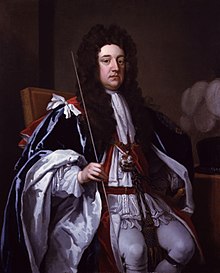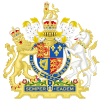|
Sidney Godolphin, 1st Earl of Godolphin
 Sidney Godolphin, 1st Earl of Godolphin, KG, PC (15 June 1645 – 15 September 1712) was an English Tory politician and peer. He was a Privy Councillor and Secretary of State for the Northern Department before he attained real power as First Lord of the Treasury. He was instrumental in negotiating and passing the Acts of Union 1707 with Scotland, which created the Kingdom of Great Britain. He had many other roles, including that of Governor of Scilly. Family and early careerHe came from an ancient Cornish family as the son of Sir Francis Godolphin (1605–1667) and nephew of the poet Sidney Godolphin. At the Restoration, he was introduced into the royal household by King Charles II of England, whose favourite he had become, and he also entered the House of Commons as member for Helston, in Cornwall. Although he spoke few words before the House, they were so to the point that he "gradually acquired a reputation as its chief if not its only financial authority". In 1668, he was a successful intermediary between the King and his sister Henrietta Anne, the wife of the Duke of Orléans, to secure an agreement with King Louis XIV of France to reject England's Dutch allies in return for French money.[1] In 1669, he was awarded a 31-year lease on all tin mines in Rialton and Retraigh in Cornwall.[1] In 1670, Godolphin was appointed Groom of the Bedchamber along with a pension of £500 per annum. He held that post until 1678. The King said that he valued Godolphin because he was "never in the way and never out of the way". Charles appointed Godolphin envoy-extraordinary to Louis XIV in 1672 to reassure France of Charles's allegiance before Louis attacked the Dutch. Godolphin was with Louis in the field during the Franco-Dutch War but was unimpressed with his capabilities as a military commander.[1] In March 1679, Godolphin was appointed a member of the Privy Council and in September was promoted, along with Viscount Hyde (afterwards Earl of Rochester) and the Earl of Sunderland, to the chief management of affairs. Exclusion and revolutionAlthough he voted for the Exclusion Bill in 1680, which, if successfully enacted, would have prevented the Catholic Duke of York from assuming the throne, Godolphin continued in office after the dismissal of Sunderland, and in September 1684, he was created Baron Godolphin of Rialton[1] and succeeded Rochester as First Lord of the Treasury. After the accession of James II, he was made chamberlain to the queen, Mary of Modena, and, along with Rochester and Sunderland, enjoyed the king's special confidence. In 1687 he was named commissioner of the treasury. Although Parliament had voted to grant James II £6,000,000, Godolphin was involved in the payment of approximately £125,000 to James II by Louis XIV in return for James's support for Louis. The historian David Ogg wrote critically that "James and his two ministers, Rochester and Godolphin, were prepared to barter the independence of England for a sum little more than a sixtieth part of that granted by the national legislature".[2][3] However, secret subsidies had also been paid to Charles II in the past, and according to Antonia Fraser, their acceptance was not "the national scandal it would be today".[4] While the purpose of such funds was clearly to circumvent the control of Parliament over the monarch, "Whig leaders [...] allowed themselves to receive similar payments"[4] from Louis XIV. Godolphin was present at the birth of the Old Pretender, but during the ensuing controversy over whether or not the birth was genuine, he diplomatically stated that he had no useful information to contribute, as he claimed to have been too far from the bed to see anything. He was one of the council of five appointed by James II to represent him in London when James left the capital to lead his army after William of Orange and his forces invaded England. Afterwards, he was appointed a commissioner to negotiate with the prince, along with Lord Halifax and Lord Nottingham. On the accession of William III, Godolphin obtained only the third seat at the treasury board, but was still in control of affairs. He retired in March 1690, but was recalled in November and appointed First Lord of the Treasury once again. Career under William III and Queen AnneWhile holding office under William III, for several years Godolphin continued, in conjunction with John Churchill (the future Duke of Marlborough), a secret correspondence with James II, and is said to have disclosed to James intelligence regarding the intended expedition against Brest during the Nine Years War. Godolphin was a Tory by inheritance, and was thought to have a romantic admiration for the wife of James II. After Fenwick's confession in 1696 regarding the attempted assassination of William III, Godolphin, who was compromised, tendered his resignation, but when the Tories came into power in 1700, he was again appointed First Lord of the Treasury. Though not technically a favourite with Queen Anne, he was after her accession appointed Lord Treasurer on the strong recommendation of Marlborough, and he retained the office for eight years. Sarah Churchill later wrote that if Anne came to learn anything about politics and statecraft, it was entirely from Godolphin's mentoring, and he eventually became "so integral a part of Anne's coterie that she and Sarah dubbed him with an alias of his own, so that in their parlance he went by, and answered to, the name of Mr Montgomery."[5] In 1704, he was also made a Knight of the Garter, and in December 1706, he was created Viscount Rialton and Earl of Godolphin. Though a Tory, he had an active share in the intrigues that gradually led to the predominance of the Whigs in alliance with Marlborough: the two were nicknamed "the Duumvirs". The influence of the Marlboroughs with the queen was, however, gradually supplanted by that of Abigail Masham and Robert Harley (later Earl of Oxford), and with the fortunes of the Marlboroughs, those of Godolphin were indissolubly united. The Queen initially relied heavily on his guidance, but relations became strained. Eventually, when he threatened to resign, she said coldly, "Do as you please... there are many to take your place". The services of both Marlborough and Godolphin were so appreciated by the nation that for a time, they regarded the loss of the queen's favour with indifference and even in 1708 to procure the expulsion of Harley from office. However, after the High Tory reaction to the impeachment of Henry Sacheverell, who had abused Godolphin under the name of Volpone, Anne made use of the opportunity to get rid of Marlborough by abruptly dismissing Godolphin from office on 7 August 1710 in tones as cold and ungrateful as those that she later used with Marlborough. Godolphin died two years later and his estate was worth more than £12,000. He is buried in the south aisle of the nave of Westminster Abbey.[6] On the wall is a bust of him by the sculptor Francis Bird.[7] Marriage and successionOn 16 May 1675, Godolphin married Margaret Blagge, daughter of Thomas Blagge, the pious lady whose life was written by John Evelyn in his book The Life of Mrs Godolphin.[8] She died in childbirth in 1678 bearing his only son, and Godolphin never remarried. Margaret is buried at Breage, Cornwall, the spot being marked by a small brass floor plaque commissioned by the Duke of Leeds. Progeny:
Gallery
Legacy The Whig historian Lord Macaulay said of Godolphin in 1848:
In the opinion of Julian Hoppit, Godolphin "tirelessly oversaw the dramatic expansion of key areas of the State, providing an element of integrity, continuity, and predictability in a very uncertain environment. He was in a very real sense Marlborough's partner and together the duumvirs oversaw the glory days of the War of the Spanish Succession. In a very real sense Marlborough's dismissal and Godolphin's death the following year marked the end of an era".[10] Roy Sundstrom asserted that Godolphin is an important figure in the history of England:
NotesReferences
Primary sources
Secondary sources
External linksWikimedia Commons has media related to Sidney Godolphin, 1st Earl of Godolphin. |
||||||||||||||||||||||||||||||||||||||||||||||||||||||||||||||||||||||||||||




